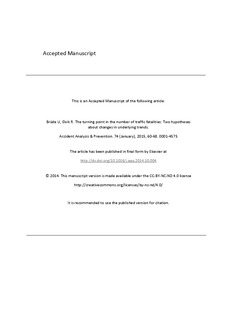| dc.contributor.author | Brüde, Ulf | |
| dc.contributor.author | Elvik, Rune | |
| dc.coverage.spatial | Denmark, Great Britain, Netherlands, Norway, Sweden, United States | nb_NO |
| dc.date.accessioned | 2019-12-20T08:24:23Z | |
| dc.date.available | 2019-12-20T08:24:23Z | |
| dc.date.created | 2015-02-06T10:50:12Z | |
| dc.date.issued | 2014-10-23 | |
| dc.identifier.citation | Accident Analysis and Prevention. 2015, 74 (January), 60-68. | nb_NO |
| dc.identifier.issn | 0001-4575 | |
| dc.identifier.uri | http://hdl.handle.net/11250/2634213 | |
| dc.description.abstract | The number of traffic fatalities reached a peak in many highly motorised countries around 1970. Some previous studies have suggested that the turning point in the number of traffic fatalities was inevitable and did not reflect a change in the underlying trends influencing the number of traffic fatalities. Other studies suggest that trends in traffic growth and fatality rate changed from before to after the turning point. This paper proposes two hypotheses about the turning point in the number of traffic fatalities. One hypothesis is that the long-term trends in traffic growth and fatality rate were the same before and after the turning point. The other hypothesis is that the long-term trends in traffic growth and fatality rate were different before and after the turning point was reached, in particular that the annual percentage decline in fatality rate became greater after the turning point than before. Such a change would suggest that road safety policy became more effective. Analysis of data for six countries (Denmark, Great Britain, Netherlands, Norway, Sweden, United States) lends stronger support to the latter hypothesis than to the former. The lesson for policy makers, in particular in countries where the number of traffic fatalities is still growing, is that they should not expect a turning point to be reached without policy interventions. | nb_NO |
| dc.language.iso | eng | nb_NO |
| dc.publisher | Elsevier | nb_NO |
| dc.rights | Attribution-NonCommercial-NoDerivatives 4.0 Internasjonal | * |
| dc.rights.uri | http://creativecommons.org/licenses/by-nc-nd/4.0/deed.no | * |
| dc.title | The turning point in the number of traffic fatalities: Two hypotheses about changes in underlying trends | nb_NO |
| dc.title.alternative | The turning point in the number of traffic fatalities: Two hypotheses about changes in underlying trends | nb_NO |
| dc.type | Journal article | nb_NO |
| dc.type | Peer reviewed | nb_NO |
| dc.rights.holder | © 2014 Elsevier Ltd. All rights reserved. | nb_NO |
| dc.description.version | submittedVersion | nb_NO |
| cristin.unitcode | 7482,0,0,0 | |
| cristin.unitname | Transportøkonomisk institutt | |
| cristin.ispublished | true | |
| cristin.fulltext | preprint | |
| cristin.qualitycode | 1 | |
| dc.identifier.doi | 10.1016/j.aap.2014.10.004 | |
| dc.identifier.cristin | 1217984 | |
| dc.source.journal | Accident Analysis and Prevention | nb_NO |
| dc.source.volume | 74 | nb_NO |
| dc.source.issue | January | nb_NO |
| dc.source.pagenumber | 60-68 | nb_NO |
| dc.relation.project | Norges forskningsråd: 210486 | nb_NO |

